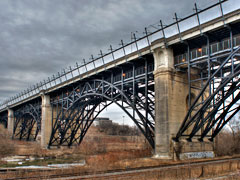Physical barriers on bridges may not decrease overall suicide rates
New research examining Toronto's Bloor Street Viaduct, formerly the world's second most frequented suicide-by-jumping site, shows that barriers on bridges may not reduce overall suicide rates in the region.
Next to the Golden Gate Bridge in San Francisco, the Bloor Street Viaduct was the most frequented bridge for suicide in the world. However a barrier at that location, erected in 2003, did not reduce the number of suicides by jumping in Toronto.
"Although the barrier prevented suicides at the Bloor Street Viaduct, there was no change in the absolute rate of suicide by jumping in Toronto due to increases in suicides from other bridges and buildings," says Dr. Mark Sinyor, Psychiatry resident at Sunnybrook and University of Toronto. "While there is clear evidence that barriers decrease or eliminate suicides at bridges commonly used for suicide, this is the first study to demonstrate that when a barrier is placed on one bridge, there can be a significant increase in suicide-by-jumping from other bridges in the area."
The study, published in the July 2010 issue of the British Medical Journal (BMJ), set out to determine whether suicide rates in Toronto changed during the four-year period after a suicide barrier was erected at the Bloor Street Viaduct.
"What this study shows us is that physical barriers alone are not sufficient to deter people who intend to commit suicide by jumping. Optimal suicide prevention programs involve comprehensive strategies to provide education, combat stigma and improve accessibility of services to individuals contemplating suicide," says Dr. Anthony Levitt, co-investigator of the study and Chief of Psychiatry at Sunnybrook.








